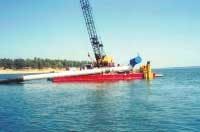Intake Design Meets 316b Regulation
By James A. French and Frank Robinson
Near Batesville, MS, a recently constructed cooling water intake provides 7,500 gallons of make up water for an 837 megawatt combined cycle electric generating facility. The intake's design and construction offer a low profile, quiet operation and "best available technology" to prevent sedimentation in the lake. And the intake also offers fish protectiveness to comply with the new EPA 316b rules.
The cooling water supply was developed from Lake Enid, a Corps of Engineer operated lake, some 15 miles south of the facility. The elevation of Lake Enid fluctuates by as much as 30 ft. as it controls and acts as a catch basin for rainfall events. Due to the contour of the lake bottom near the site, this drop in water level means the water line moves up to 800 ft. out from the bank. A conventional intake, with traveling screens could not be constructed on-shore, but would have to be constructed in the lake. This would be obtrusive to the lake's recreational purposes. An intake constructed in the lake also is not easily serviced.
A caisson on shore with a bored and jacked intake line (fixed screen Intake) was the selected method of construction, but the distance from the caisson of 900 linear ft. made microtunnelling too expensive.
If the engineers could construct the intake line at a higher elevation so that the longest run of pipe could be trenched in when the lake was at its lowest point, then they could realise large savings. The engineers settled on a version of the fixed screen intake (siphon type) having a 20 ft. diameter reinforced caisson on shore, and a 900 ft. intake line. The entire system would operate by suction.
The normal construction technique is to sink the caisson by the open-end caisson sinking method, bore and jack or microtunnel the line into the water and connect to the screens via marine equipment.
What made this project unique was the fact that the intake was constructed in reverse. Normally the shaft would be sunk, the line bored, and the screen set. Here due to the fluctuation of the lake, its changing profile, and the screen location, the construction methods had to be reversed.
Construction began in January 1999 when the level of the lake was lowest. A jacking pit was constructed in the dry lake bottom and a 36-in. bored and jacked line was installed into the caisson. From there, the line was trenched 700ft. to the water's edge. Then the remaining pipe and screen were installed from a barge.
About the Authors: James A. French is vice president at Collector Wells International, Inc. in Columbus, OH. Frank Robinson is president of Robinson Construction in Perryville, MO.


